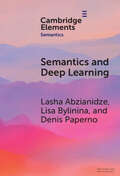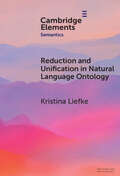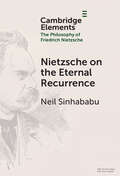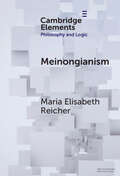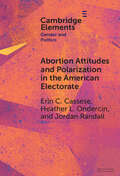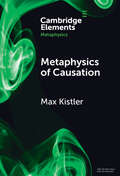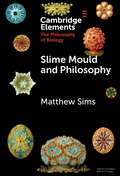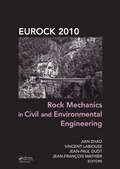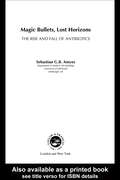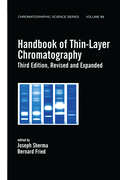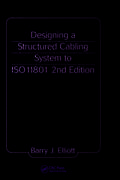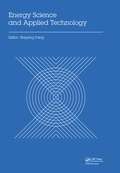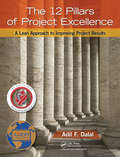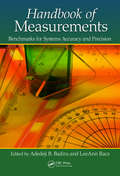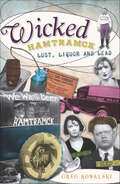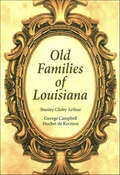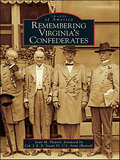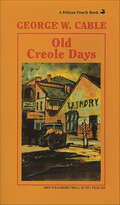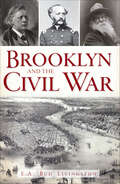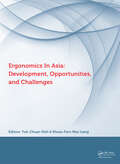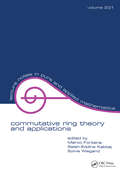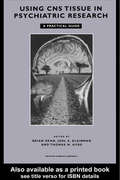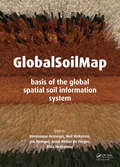- Table View
- List View
Semantics and Deep Learning (Elements in Semantics)
by Lasha Abzianidze Lisa Bylinina Denis PapernoThis Element covers the interaction of two research areas: linguistic semantics and deep learning. It focuses on three phenomena central to natural language interpretation: reasoning and inference; compositionality; extralinguistic grounding. Representation of these phenomena in recent neural models is discussed, along with the quality of these representations and ways to evaluate them (datasets, tests, measures). The Element closes with suggestions on possible deeper interactions between theoretical semantics and language technology based on deep learning models.
Reduction and Unification in Natural Language Ontology (Elements in Semantics)
by Kristina LiefkeSemantic theories for natural language assume many different kinds of objects, including (among many others) individuals, properties, events, degrees, and kinds. Formal type-theoretic semantics tames this 'zoo' of objects by assuming only a small number of ontologically primitive categories and by obtaining the objects of all other categories through constructions out of these primitives. This Element surveys arguments for this reduction of semantic categories. It compares the ontological commitments of different such reductions and establishes relations between competing foundational semantic ontologies. In doing so, it yields insights into the requirements on minimal semantic ontologies for natural language and the challenges for semantic ontology engineering.
Nietzsche on the Eternal Recurrence (Elements in the Philosophy of Friedrich Nietzsche)
by Neil SinhababuThe idea of the eternal recurrence is that we will live the exact same lives again an infinite number of times. Nietzsche appreciates that this would multiply the value of a single life by infinity, justifying intense emotional responses. His unpublished notes provide a cosmological argument for the eternal recurrence that anticipates Poincaré's recurrence theorem. Nietzsche's Thus Spoke Zarathustra describes its hero discovering this idea and struggling to accept the recurrence of all bad things. He eventually comes to love the eternal recurrence because it will bring back all the joys of his life, and teaches this idea to others.
Meinongianism (Elements in Philosophy and Logic)
by Maria Elisabeth ReicherMeinongianism (named after Alexius Meinong) is, roughly, the view that there are not only existent but also nonexistent objects. In this book, Meinong's so-called object theory as well as “neo-Meinongian” reconstructions are presented and discussed, especially with respect to logical issues, both from a historical and a systematic perspective. Among others, the following topics are addressed: basic principles and motivations for Meinongianism; the distinction between “there is” (“ x”) and “exists” (“E!”); interpretations and kinds of quantification; Meinongianism, the principle of excluded middle and the principle of non-contradiction; the nuclear-extranuclear distinction and modes of predication; varieties of neo-Meinongianism and Meinongian logics.
Abortion Attitudes and Polarization in the American Electorate (Elements in Gender and Politics)
by Erin C. Cassese Heather L. Ondercin Jordan RandallAbout two-thirds of Americans support legal abortion in many or all circumstances, and this group finds itself a frustrated majority following the Supreme Court's 2022 decision in Dobbs v. Jackson Women's Health Organization which overturned the legal precedent set in Roe v. Wade. Previous scholarship argues intense minorities can secure favorable policy outcomes when facing off against a more diffuse and less motivated majority, creating incongruence between public opinion and policy. This Element focuses on the ways that preference intensity and partisan polarization have contributed to the current policy landscape surrounding abortion rights. Using survey data from the American National Election Studies, the authors identify Americans with intense preferences about abortion and investigate the role they play in electoral politics. They observe a shift in the relationship between partisanship and preference intensity coinciding with Dobbs and speculate about what this means for elections and policy congruence in the future.
Metaphysics of Causation (Elements in Metaphysics)
by Max KistlerThis Element presents the main attempts to account for causation as a metaphysical concept, in terms of 1) regularities and laws of nature, 2) conditional probabilities and Bayes nets, 3) necessitation between universals and causal powers, 4) counterfactual dependence, 5) interventions and causal models, and 6) processes and mechanisms. None of these accounts can provide a complete reductive analysis. However, some provide the means to distinguish several useful concepts of causation, such as total cause, contributing cause, direct and indirect cause, and actual cause. Moreover, some of these accounts can be construed so as to complement each other. The last part presents some contemporary debates: on the relation between grounding and causation, eliminativism with respect to causation in physics, the challenge against 'downward' causation from the Closure and Exclusion principles, robust and proportional causation, and degrees of causation. This title is also available as Open Access on Cambridge Core.
Slime Mould and Philosophy (Elements in the Philosophy of Biology)
by Matthew SimsPhysarum polycephalum, also known more colloquially as 'the blob', 'acellular slime mould', or just 'slime mould', is a unicellular multinucleate protist that has continued to attract the interest of biologists over the past century because of its complex life cycle, unique physiology, morphology, and behaviour. More recently, attention has shifted to Physarum as a model organism for investigating putative cognitive capacities such as decision making, learning, and memory in organisms without nervous systems. The aim of this Element is to illustrate how Physarum can be used as a valuable tool for approaching various topics in the philosophy of biology. Physarum and its behaviour not only pose a challenge to some of the received views of biological processes but also, I shall argue, provide an opportunity to clarify and appropriately sharpen the concepts underlying such received views.
Rock Mechanics in Civil and Environmental Engineering
by Jian Zhao Vincent Labiouse Jean-Paul Dudt Jean-François MathierDuring the last two decades rock mechanics in Europe has been undergoing some major transformation. The reduction of mining activities in Europe affects heavily on rock mechanics teaching and research at universities and institutes. At the same time, new emerging activities, notably, underground infrastructure construction, geothermal energy develo
Magic Bullets, Lost Horizons: The Rise and Fall of Antibiotics
by Sebastian G. AmyesFrom the day that Paul Ehrlich hailed his newly discovered treatment for syphilis as the magic bullet, antibiotics have transformed medical practice. They are considered one of the miracle drugs of the 20th century. However, the massive and increasing misuse of these agents is More...causing a problem of resistance that may prove to be one of the greatest threats to health in the 21st century. Magic Bullets, Lost Horizons aims to put some of the media sensationalism into perspective. It examines not only the development of modern antibiotics but also the obstacles faced during application of the drugs and their expected efficacy in the future.
Handbook of Thin-Layer Chromatography
by Bernard Fried Joseph ShermaIn this third edition, more than 40 renowned authorities introduce and update chapters on the theory, fundamentals, techniques, and instrumentation of thin-layer chromatography (TLC) and high-performance thin-layer chromatography (HPTLC), highlighting the latest procedures and applications of TLC to 19 important compound classes and coverage of TLC applications by compound type. Easily adaptable to industrial scenarios , the Handbook of Thin-Layer Chromatography, Third Edition supports practical research strategies with extensive tables of data, offers numerous figures that illustrate techniques and chromatograms, and includes a glossary as well as a directory of equipment suppliers.
Designing a Structured Cabling System to ISO 11801
by Barry J. ElliotCovering major standards and relevant design issues, this book explains how to specify, install, and test a modern reliable structured cabling system and analyzes the terminology and physics behind the standards. The author empowers the reader with the skills required to read and understand standards and address problems raised by the need to design, procure, install, and test a modern cabling system, using both copper and optical fiber cable technology. He thoroughly discusses the technology and the vast number of standards that accompany it. The material is based on the design recommendations of ISO/IEC 11801. The appendix lists relevant standards and provides contacts for standards organizations.
Energy Science and Applied Technology: Proceedings of the 2nd International Conference on Energy Science and Applied Technology (ESAT 2015)
by Zhigang FangEnergy Science and Applied Technology includes contributions on a wide range of topics:- Technologies in geology, mining, oil and gas exploration and exploitation of deposits- Energy transfer and conversion, materials and chemical technologies- Environmental engineering and sustainable development- Electrical and electronic technology, power system
The 12 Pillars of Project Excellence: A Lean Approach to Improving Project Results
by Adil F. DalalAsking tough questions about the current state of project management, The 12 Pillars of Project Excellence: A Lean Approach to Improving Project Results provides groundbreaking techniques to achieve excellence in project leadership that can result in six sigma type results or failure-free projects. It unveils novel solutions and breakthrough concepts—including project culture analysis, the five powers of project leadership, the power of visualization™, the science of simplicity™, dynamic risk leadership, and dynamic project failures analysis—to help you chart the most efficient path to the pinnacle of project leadership.Winner of a 2013 Axiom Business Book AwardThe author provides the cutting-edge methods based on decades of personal practical experience, valuable lessons learned, and authoritative insights gained from leading over 300 projects to successful conclusions. Complete with powerful tools for organizational- and self-assessment on the accompanying downloadable resources, this book will not only transform your approach to project management, but will also provide you with the tools to develop effective leaders and consistently achieve exceptional business results.Some Praise for the Book:… a highly pragmatic guide to project management. … lays out the way of thinking that underpins success… a book that everyone could benefit from.—Mikel J. Harry, Ph.D., co-creator of Six Sigmaprovides the most significant contribution for leaders to mitigate project risks, assure sustainable growth, and guarantee survival… .—Carlos Alberto Briganti, general manager of Eaton Europe and Japan, 2001-2003; vice president of Eaton South America 2004-2007… one of the BEST books I have ever read on project leadership.—John Salazar, CIO Department of Work Force Solutions; former CIO of Department of Taxation & Revenue, State of New Mexico… a comprehensive guide that will assist any business leader within an organization to consistently achieve excellent business results! A ‘must buy’—get it now!—Billy Billimoria, director, customer applications, BAE Systems; program director, Lockheed Martin; project engineer, Space Shuttle and Support Equipment Design
Handbook of Measurements: Benchmarks for Systems Accuracy and Precision (Systems Innovation Book Series)
by Adedeji B. Badiru LeeAnn RaczPlanning, measuring, and paying attention to details form the basis for all successful engineering operations. Measurements pervade everything we do and must be viewed from a systems perspective. A comprehensive all-encompassing guide to measurements, Handbook of Measurements: Benchmarks for Systems Accuracy and Precision focuses on high-level engineering computations essential for benchmarks and technical innovation. The book uses a systems framework and a technically rigorous approach to systems linking of measurements—an approach that sets it apart from other handbooks.The popular saying "measure twice and cut once" bears out the importance of measurements in human endeavors. This handbook covers both qualitative and quantitative topics of measurement. It opens with a chapter on the fundamentals of measurement and includes coverage of human-centric measurements, such as measurement of personnel productivity and contractor performance. It concludes with three appendices on measurement, references, conversion factors, equations, formulas, and statistics for measurement.It is well understood that humans cannot manage anything that cannot be measured. All elements involved in our day-to-day decision making involve some form of measurement, whether in the kitchen, retail, sports, service operations, geographical exploration, health care delivery, worker productivity, clothing design, engineering product design, or space craft launching. Measuring an attribute of a system and then analyzing it against some standard, some specification, some best practice, or some benchmark empower a decision maker to take appropriate and timely actions. This book gives you a guide for sustainable practices to ensure accurate measurements, helping you make decisions backed by metrics.
Wicked Hamtramck: Lust, Liquor and Lead (Wicked)
by Greg KowalskiHamtramck's population bulged to 56,000 from a mere 3,500 in the early twentieth century, a sixteen-fold increase that created the perfect environment for crime and corruption to flourish. Post-Prohibition, bars sprang up in quick order, until there were at least two hundred within this wide-open town's 2.1 square miles, giving it more bars per capita than any other city in America; even the Dodge brothers served barrels of beer to their workers. Follow local historian Greg Kowalski through the underbelly of Hamtramck, from the "painted women openly flaunting their tainted charms from undraped windows" to the nefarious plots crafted behind the walls of the International Workers Home on Yemens Street. Welcome to the height of Hamtramck's infamy, where anything could happen--for a price.
Old Families of Louisiana
by Stanley ArthurOriginally published in 1931, Old Families of Louisiana was compiled in response to a demand for a comprehensive series of genealogical records of the foundation families of the state--families whose ancestors settled with Bienville in New Orleans at the time the famous old city was laid out in the crescent bend of the Mississippi River. This book also answers the call for information on those who came to Louisiana when the golden lilies of France, the castellated banner of Spain, the Union Jack of Great Britain, or the flag of fifteen stars and fifteen stripes waved over the land.During the compilation of the original data it became apparent that the present book would be greatly augmented in interest and value by the addition of genealogical records of other prominent foundation families besides the French and Spanish. For this reason, information was included on the English, Scottish, and Irish lineages whose representatives now form an integral part of the present-day population of Louisiana.In the seventy years since its first publication, Old Families of Louisiana has exceeded the original scope intended. In order to set a limit to its range, it was agreed that only those families settling in Louisiana before and up to the time of the beginning of the American domination in 1803 should be included. Old Families of Louisiana traces the genealogy of such traditional Louisiana families as Fortier, Claiborne, Kenner, Percy, Wiltz, Chalmette, Landry, Derbigny, Butler, St. Martin, and Wilkinson.
Remembering Virginia's Confederates (Images of America)
by Sean M. HeuvelThe commonwealth of Virginia holds a prominent and distinguished place in American Civil War history. Home to the Confederacy's capital city of Richmond, more major battles were fought in Virginia than in any other state. The commonwealth also produced some of the war's most legendary and iconic figures, including Robert E. Lee, Thomas J. "Stonewall" Jackson, and J. E. B. Stuart. Images of America: Remembering Virginia's Confederates explores the Confederate military and government service of a wide array of Virginia residents, ranging from the most prominent generals, politicians, and spies to little-known enlisted men. It also acknowledges their dedication and sacrifice to a cause in which they strongly believed.
Old Creole Days (Pelican Pouch)
by George CableThese stories reflect the Creole way of life during the transitory post-Civil War period.
Brooklyn and the Civil War (Civil War Series)
by E.A. "Bud" LivingstonWhile Manhattan was the site of many important Civil War events, Brooklyn also played an important part in the war. Henry Ward Beecher "auctioned off" slaves at the Plymouth Church, raising the money to free them. Walt Whitman reported news of the war in a Brooklyn paper and wrote some of his most famous works. At the same time, Brooklyn both grappled with and embraced unique challenges, from the arrival of new immigrants to the formation of one of the nation's first baseball teams. Local historian Bud Livingston crafts the portrait of Brooklyn in transition--shaped by the Civil War while also leaving its own mark on the course of the terrible conflict.
Ergonomics in Asia: Proceedings of the 2nd East Asian Ergonomics Federation Symposium (EAEFS 2011), National Tsing Hua University, Hsinchu, Taiwan,4 - 8 October 2011
by Yuh-Chuan Shih Sheau-Farn Max Liang Yu-Hsing Huang Yu-Cheng Lin Chih-Long LinFor the past decade, the rapid development of the ergonomics disciplines as well as the fast growing economy in the Asian region have been attracting the attention of the international ergonomics community. Although East Asia has been changing from a traditional agriculture-oriented society into a modern industry-oriented society and its economy co
Contemporary Ergonomics and Human Factors 2012: Proceedings of the international conference on Ergonomics & Human Factors 2012, Blackpool, UK, 16-19 April 2012 (Contemporary Ergonomics)
by Martin AndersonThe broad and developing scope of ergonomics - the application of scientific knowledge to improve people‘s interaction with products, systems and environments - has been illustrated for 25 years by the books which make up the Contemporary Ergonomics series. This book presents the proceedings of the international conference on Ergonomics and Human F
Advances in Engineering Materials and Applied Mechanics: Proceedings of the International Conference on Machinery, Materials Science and Engineering Application, (MMSE 2015), Wuhan, China, June 27-28 2015
by Qiang Xu Guangde Zhang Quanjie GaoWith the rapid development of Machinery, Materials Science and Engineering Application, discussion on new ideas related mechanical engineering and materials science arise. In this proceedings volume the author(s) are focussed on Machinery, Materials Science and Engineering Applications and other related topics. The Conference has pro
Commutative Ring Theory and Applications (Lecture Notes in Pure and Applied Mathematics)
by Salah-Eddine Kabbaj Sylvia Wiegand Manco FontanaFeaturing presentations from the Fourth International Conference on Commutative Algebra held in Fez, Morocco, this reference presents trends in the growing area of commutative algebra. With contributions from nearly 50 internationally renowned researchers, the book emphasizes innovative applications and connections to algebraic number theory, geome
Using CNS Autopsy Tissue in Psychiatric Research: A Practical Guide
by Brian Dean Thomas M Hyde Joel E KleinmanEssential for the laboratory, this practical manual presents a wide variety of techniques associated with the use of human CNS tissue obtained at autopsy. The book contains detailed methodologies in discrete chapters written by an expert in the specific field. It also addresses the potential for extending molecular studies in brain tissue obtain
GlobalSoilMap: Basis of the global spatial soil information system
by Dominique ArrouaysGlobalSoilMap: Basis of the global spatial soil information system contains contributions that were presented at the 1st GlobalSoilMap conference, held 7-9 October 2013 in Orl‘s, France. These contributions demonstrate the latest developments in the GlobalSoilMap project and digital soil mapping technology for which the ultimate aim is to produce a
